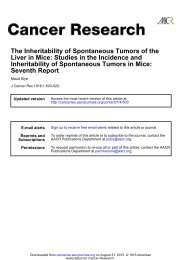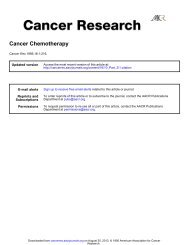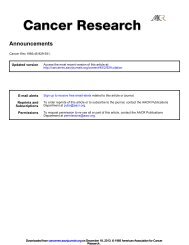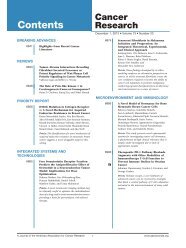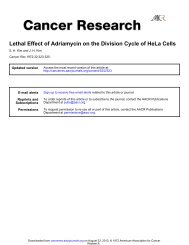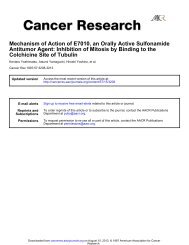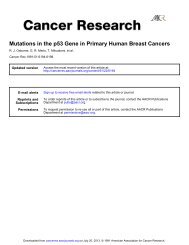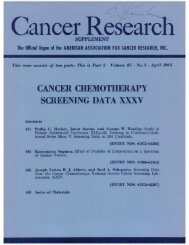XANTHOMA OF THE BREAST In a series of nine hundred (circa ...
XANTHOMA OF THE BREAST In a series of nine hundred (circa ...
XANTHOMA OF THE BREAST In a series of nine hundred (circa ...
You also want an ePaper? Increase the reach of your titles
YUMPU automatically turns print PDFs into web optimized ePapers that Google loves.
Downloaded from cancerres.aacrjournals.org on December 28, 2013. © 1932<br />
American Association for Cancer Research.<br />
1092 CUSHMAN D. HAAGENSEN<br />
COMMENT: These three cases <strong>of</strong> xanthoma are presumably<br />
examples <strong>of</strong> the solitary tumor-like type <strong>of</strong> primary xanthoma<br />
occurring in the syndrome <strong>of</strong> xanthomatosis. <strong>In</strong> the first patient<br />
the presence <strong>of</strong> diabetes as well as nephritis suggests a disturbed<br />
cholesterin metabolism. The blood cholesterin was found to be<br />
within normal limits when it was determined a year after operation.<br />
The second patient had nephritis, a frequent cause <strong>of</strong> xanthoma.<br />
<strong>In</strong> the third patient there was no apparent correlation between the<br />
supraclavicular and bone carcinoma metastases and the finding <strong>of</strong> a<br />
pure xanthoma in the subcutaneous tissue <strong>of</strong> the chest wall at the<br />
site <strong>of</strong> the amputated breast.<br />
B. Secondary Xanthomatous Degeneration in the Breast<br />
(1) Secondary Xanthomatous Degeneration in True Neoplasms oj<br />
the Breast: Groups <strong>of</strong> foam cells are not infrequently seen in fibroadenomas<br />
and carcinomas <strong>of</strong> the breast. They occur as a degenerative<br />
phenomenon in the poorly nourished or necrotic portions<br />
<strong>of</strong> these tumors. The fact that the breast is a fatty organ, and in<br />
addition secretes fat-containing milk which may be inspissated,<br />
may favor such xanthomatous degeneration in neoplasms <strong>of</strong> the<br />
breast. <strong>In</strong>' any event it is a common finding. Lobeck has made<br />
the most complete study <strong>of</strong> the subject. <strong>In</strong> 118 amputated breasts<br />
he found secondary xanthomatous degeneration sixteen times in<br />
carcinoma and once in a fibro-adenoma. He did blood cholesterin<br />
determinations in thirteen <strong>of</strong> these patients and found what he<br />
considered an abnormally high blood cholesterin in every instance.<br />
Gross described a large fibro-adenoma <strong>of</strong> the breast showing<br />
secondary xanthomatous degeneration. The patient's blood cholesterin<br />
was markedly elevated (400 mg.), Hedinger and Miller<br />
have also reported xanthomatous fibro-adenomas.<br />
No attempt will be made to report all the instances <strong>of</strong> breast<br />
neoplasms showing secondary xanthomatous degeneration in the<br />
records <strong>of</strong> the Memorial Hospital. The condition is too inconsequential<br />
to warrant such attention. The following is an illustrative<br />
case <strong>of</strong> secondary xanthomatous degeneration occurring in<br />
a giant intracanalicular fibro-adenoma.<br />
CASE 4: D. K., a married American woman, aged fifty-six, came to<br />
the Memorial Hospital, Dec. 23, 1928.<br />
Past History: She had had seven normal pregnancies and had nursed<br />
all seven children for more than two years without. any difficulty with<br />
her breasts. The last lactation had been twenty-six years before.



